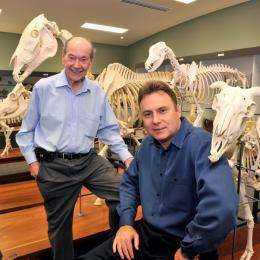Scientists present evidence for groundbreaking evolution theory

The popular belief among scientists that certain sequences of DNA are relatively unimportant in the evolutionary process has been turned on its head by two Murdoch University researchers.
PhD student Keith Oliver and Associate Professor Wayne Greene have spent the last two years gathering a wealth of evidence which proves that what are commonly known as jumping genes are actually driving the evolutionary process in some species.
Jumping genes are sequences of DNA that can move to new positions within the genome of a cell. This movement can create mutations and therefore change the observable characteristics of a species.
Their latest scientific paper on the idea brings together around 100 examples of where the activity of jumping genes have created or greatly-modified primate and human genes, resulting in the generation of well-known primate-specific traits.
“Visual red-green colour perception, faster brain function, better foetal nutrition in the womb along with a more assertive placenta and better infectious disease resistance are just some of the evolutionary advances in primates brought about by jumping genes,” said A/Prof Greene, who is Academic Chair of Biomedical Science.
“In fact, it’s very hard to see how primates and humans could have evolved in the way they have, without the intervention of jumping genes.”
Mr Oliver and A/Prof Greene have further developed their theory into four modes that help shed light on why evolution sometimes occurs in fits and starts, sometimes gradually and sometimes hardly at all. Therefore, their jumping gene theory helps to explain a number of mysteries in biology, including why species suddenly appear in the fossil record, why some groups of organisms are species-rich and others are species-poor.
“Lineages with active jumping genes or large uniform populations of them spawn new species readily because they possess a greater ability to evolve, diversify and survive. An example of this is bats,” said Mr Oliver.
“But species which are deficient in jumping genes or with inactive jumping genes tend to risk extinction because they lack the capacity to adapt, change and diversify. The so-called ‘living fossils’ like the fish coelacanth and the reptile tuatara are good examples.
“It also helps to explain why some species change little over millions of years like these living fossils. And why almost all species do not eliminate this junk DNA from their genomes.”
A/Prof Greene said he and Mr Oliver are hoping their jumping gene theory is further tested across different species by researchers in the field.
“With this work we are unquestionably standing on the shoulders of others that have worked on jumping genes, but we are certainly the first to bring all their work together for what we believe is the most persuasive case ever put forward on the pivotal role of jumping genes in evolution.”
A/Prof Greene and Mr Oliver first published their jumping gene theory in the prestigious BioEssays journal in 2009. The second paper with evidence for their claims was recently published in the Mobile DNA journal.
Provided by Murdoch University
















